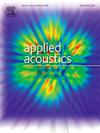可编程电声衬垫在某典型涡扇设备上的试验评估
IF 3.4
2区 物理与天体物理
Q1 ACOUSTICS
引用次数: 0
摘要
Flightpath 2050欧盟严格的航空降噪法规,以及新一代超高涵道比涡轮风扇降低油耗,极大地挑战了科学界寻找前所未有的声学衬垫设计。通过设计和测试由电声谐振器组成的可编程超表面,SALUTE H2020项目已经接受了这一挑战。每个电声谐振器由一个扬声器和四个紧凑设计的麦克风组成,通过电流驱动的控制策略,可以合成可调的局部阻抗行为。安装在穿孔板上的钢丝网可以保护机电设备免受空气动力学干扰。这种先进的尾管概念首次在里昂中央理工学院流体力学和声学实验室的ECL-B3 PHARE-2涡轮风扇钻机上进行了测试。本文报道的电声衬垫的性能,对应于三种不同的制度:30%,40%和100%的名义发动机转速。该电声技术在实际涡扇条件的逼真再现中表现出鲁棒性,并具有针对不同频率带宽的可调性,达到了良好的辐射降噪效果。结果报告在这个实验活动打开了前所未有的内衬设计的大门,通过开发可编程表面的巨大潜力。本文章由计算机程序翻译,如有差异,请以英文原文为准。
Experimental assessment of a programmable Electroacoustic Liner in a representative turbofan facility
The Flightpath 2050 European Union stringent regulations for aviation noise reduction, along with the new generation of Ultra-High-Bypass-Ratio turbofans to reduce fuel consumption, significantly challenge the scientific community to find unprecedented acoustic liner designs. The SALUTE H2020 project has taken up this challenge, by designing and testing a programmable metasurface made up of electroacoustic resonators. Each electroacoustic resonator is composed by a loudspeaker and four microphones in a compact design, allowing to synthesize tunable local impedance behaviours thanks to a current-driven control strategy. A steel wiremesh mounted onto a perforated plate allows to protect the elctromechanical devices from the aerodynamic disturbances. For the first time, such advanced liner concept has been tested in a scaled turbofan rig: the ECL-B3 PHARE-2 in the Laboratory of Fluid Mechanics and Acoustics of the Ecole Centrale of Lyon. The performances of the electroacoustic liner reported in this paper, correspond to three different regimes: 30%, 40% and 100% of the nominal engine speed. The electroacoustic technology demonstrated robustness faced with a realistic reproduction of actual turbofan conditions, as well as its tunability to target different frequency bandwidth, attaining good radiated noise reduction. The results reported in this experimental campaign open the doors for unprecedented liner designs, by exploiting the huge potentialities of programmable surfaces.
求助全文
通过发布文献求助,成功后即可免费获取论文全文。
去求助
来源期刊

Applied Acoustics
物理-声学
CiteScore
7.40
自引率
11.80%
发文量
618
审稿时长
7.5 months
期刊介绍:
Since its launch in 1968, Applied Acoustics has been publishing high quality research papers providing state-of-the-art coverage of research findings for engineers and scientists involved in applications of acoustics in the widest sense.
Applied Acoustics looks not only at recent developments in the understanding of acoustics but also at ways of exploiting that understanding. The Journal aims to encourage the exchange of practical experience through publication and in so doing creates a fund of technological information that can be used for solving related problems. The presentation of information in graphical or tabular form is especially encouraged. If a report of a mathematical development is a necessary part of a paper it is important to ensure that it is there only as an integral part of a practical solution to a problem and is supported by data. Applied Acoustics encourages the exchange of practical experience in the following ways: • Complete Papers • Short Technical Notes • Review Articles; and thereby provides a wealth of technological information that can be used to solve related problems.
Manuscripts that address all fields of applications of acoustics ranging from medicine and NDT to the environment and buildings are welcome.
 求助内容:
求助内容: 应助结果提醒方式:
应助结果提醒方式:


